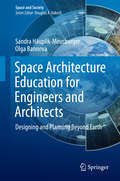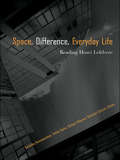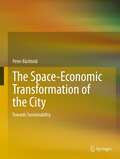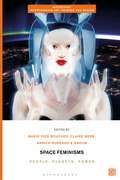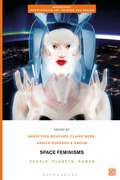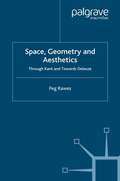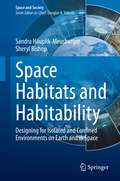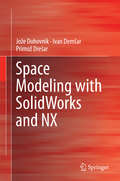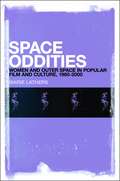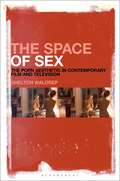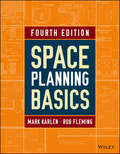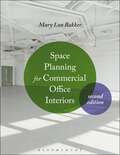- Table View
- List View
Space Architecture: The New Frontier for Design Research (Architectural Design)
by Neil LeachForty years on from the first moon landing, architecture in Space is entering a new era. Over the last decade, there has been a fundamental shift in the Space industry from short-term pioneering expeditions to long-term planning for colonisation, and new ventures such as Space tourism. Architects are now involved in designing the interiors of long-term habitable structures in Space, such as the International Space Station, researching advanced robotic fabrication technologies for building structures on the Moon and Mars, envisioning new 'space yachts' for the super-rich, and building new facilities, such as the Virgin Galactic 'Spaceport America' in New Mexico designed by Foster + Partners. Meanwhile the mystique of Space remains as alluring as ever, as high-profile designers and educators – such as Greg Lynn – are running designs studios drawing upon ever more inventive computational design techniques. This issue of AD features the most significant current projects underway and highlights key areas of research in Space, such as energy, materials, manufacture and robotics. It also looks at how this research and investment in new technologies might transfer to terrestrial design and construction. Space architects: Constance Adams, Marc Cohen, Ondrej Doule, Sandra Häuplik-Meusburger, Scott Howe, Brent Sherwood, Madhu Thangavelu, Andreas Vogler, Robert Zubrin. Architects: Bevk Perovic Arhitekti, Dekleva Gregoric Arhitekti, Foster + Partners, Neil Leach, Greg Lynn, OFIS architects, SADAR + VUGA.
Space Architecture Education for Engineers and Architects: Designing and Planning Beyond Earth (Space and Society)
by Sandra Häuplik-Meusburger Olga BannovaThis book considers two key educational tools for future generations of professionals with a space architecture background in the 21st century: (1) introducing the discipline of space architecture into the space system engineering curricula; and (2) developing space architecture as a distinct, complete training curriculum. Professionals educated this way will help shift focus from solely engineering-driven transportation systems and “sortie” missions towards permanent off-world human presence. The architectural training teaches young professionals to operate at all scales from the “overall picture” down to the smallest details, to provide directive intention–not just analysis–to design opportunities, to address the relationship between human behavior and the built environment, and to interact with many diverse fields and disciplines throughout the project lifecycle. This book will benefit individuals and organizations responsible for planning transportation and habitat systems in space, while also providing detailed information on work and design processes for architects and engineers.
Space, Difference, Everyday Life: Reading Henri Lefebvre
by Kanishka Goonewardena Stefan Kipfer Richard Milgrom Christian SchmidIn the past fifteen years, Henri Lefebvre’s reputation has catapulted into the stratosphere, and he is now considered an equal to some of the greats of European social theory (Bourdieu, Deleuze, Harvey). In particular, his work has revitalized urban studies, geography and planning via concepts like; the social production of space, the right to the city, everyday life, and global urbanization. Lefebvre’s massive body of work has generated two main schools of thought: one that is political economic, and another that is more culturally oriented and poststructuralist in tone. Space, Difference, and Everyday Life merges these two schools of thought into a unified Lefebvrian approach to contemporary urban issues and the nature of our spatialized social structures.
Space, Difference, Everyday Life: Reading Henri Lefebvre
by Kanishka Goonewardena Stefan Kipfer Richard Milgrom Christian SchmidIn the past fifteen years, Henri Lefebvre’s reputation has catapulted into the stratosphere, and he is now considered an equal to some of the greats of European social theory (Bourdieu, Deleuze, Harvey). In particular, his work has revitalized urban studies, geography and planning via concepts like; the social production of space, the right to the city, everyday life, and global urbanization. Lefebvre’s massive body of work has generated two main schools of thought: one that is political economic, and another that is more culturally oriented and poststructuralist in tone. Space, Difference, and Everyday Life merges these two schools of thought into a unified Lefebvrian approach to contemporary urban issues and the nature of our spatialized social structures.
The Space-Economic Transformation of the City: Towards Sustainability
by Peter BachtoldCity planning is the key-stone to tackle the question of climate-change and to involve adequate action. In Part I of this book, the theory of space-economy is presented. Opening up a new conceptual and operational toolbox for policy makers, practitioners and scholars, the theory of space-economy is based on a rigorously structured thinking and acting in the field of sustainable urban planning and architecture.Europe has the greatest experience in sustainable city planning worldwide. In Part II, four of the most remarkable experiences (Vauban in Freiburg i.B., Kronsberg in Hannover, Western Harbour in Malmö, Hammarby Sjöstad in Stockholm) are presented, dissected conceptually and operationally a radically new way. The interest of the approach is not limited to European countries.In Part III is developed a project in Asia, in Ho Chi Minh City, faced with dramatic threats due to climate change and rapidly growing tidal and sea-level rise. Based on the experiences presented in Part II, the approach is integrated in this completely different context, thus becoming fully effective at a much bigger scale.
Space-Efficient Data Structures, Streams, and Algorithms: Papers in Honor of J. Ian Munro, on the Occasion of His 66th Birthday (Lecture Notes in Computer Science #8066)
by Andrej Brodnik Alejandro Lopez-Ortiz Venkatesh Raman Alfredo ViolaThis Festschrift volume, published in honour of J. Ian Munro, contains contributions written by some of his colleagues, former students, and friends. In celebration of his 66th birthday the colloquium "Conference on Space Efficient Data Structures, Streams and Algorithms" was held in Waterloo, ON, Canada, during August 15-16, 2013. The articles presented herein cover some of the main topics of Ian's research interests. Together they give a good overall perspective of the last 40 years of research in algorithms and data structures.
Space Feminisms: People, Planets, Power (Biotechne: Interthinking Art, Science and Design)
by Marie-Pier Boucher, Claire Webb, Annick Bureaud, and NahumEmploying a global approach to feminist theory, this book examines how scientific, popular, scholarly, and artistic imaginations of space have, since the 1950s, reflected and embedded Earthly hopes, anxieties, and futures.Rather than simply a platform for imagining the future, it cultivates radical and alternative modes of inquiry around space through seeing space as a material reality that reflexively encodes humans' self-perceptions of their planet and beyond. Bringing together essayistic reflections, artworks, and interviews with space scientists, engineers, and astronauts past and present in one volume, Space Feminisms inspects the transformation of terrestrially held notions of gender, race, class, and ableism as they migrate to the extraterrestrial, whilst drawing new connections between feminist thought and extraterrestrial power structures.Space Feminisms makes a radical enquiry into how earthly power structures are already expanding into our skies, facilitating a collaborative and interdisciplinary platform for scholars, artists, and designers to imagine radical constructions of human futures beyond Earth. At the intersection of scientific, cultural, social, and artistic speculations, the book gathers leading scholars, scientists, artists, and designers to develop innovative tactics and disruptive participations to create generative, alternative, and radical futures of and in space.
Space Feminisms: People, Planets, Power (Biotechne: Interthinking Art, Science and Design)
Employing a global approach to feminist theory, this book examines how scientific, popular, scholarly, and artistic imaginations of space have, since the 1950s, reflected and embedded Earthly hopes, anxieties, and futures.Rather than simply a platform for imagining the future, it cultivates radical and alternative modes of inquiry around space through seeing space as a material reality that reflexively encodes humans' self-perceptions of their planet and beyond. Bringing together essayistic reflections, artworks, and interviews with space scientists, engineers, and astronauts past and present in one volume, Space Feminisms inspects the transformation of terrestrially held notions of gender, race, class, and ableism as they migrate to the extraterrestrial, whilst drawing new connections between feminist thought and extraterrestrial power structures.Space Feminisms makes a radical enquiry into how earthly power structures are already expanding into our skies, facilitating a collaborative and interdisciplinary platform for scholars, artists, and designers to imagine radical constructions of human futures beyond Earth. At the intersection of scientific, cultural, social, and artistic speculations, the book gathers leading scholars, scientists, artists, and designers to develop innovative tactics and disruptive participations to create generative, alternative, and radical futures of and in space.
Space, Geometry and Aesthetics: Through Kant and Towards Deleuze (Renewing Philosophy)
by P. RawesExamining multiple modes of spatio-temporal and geometric figurations of life, the author explores how relationships between space, geometry and aesthetics generate productive expressions of subjectivity, developed through Kant's 'reflective subject' and 'geometric' texts by Plato and others towards Deleuze's philosophy of sense.
Space Grid Structures
by John ChiltonA space frame is a three-dimensional framework for enclosing spaces in which all members are interconnected and act as a single entity. A benefit of this type of structure is that very large spaces can be covered, uninterrupted by support from the ground. John Chilton's book provides an up-to-date assessment of the use of space grid structures in buildings by reviewing methods of construction, various systems available and detailed studies of the use of space grids in modern buildings. The technical level is aimed at professional and student architects and engineers worldwide and it also serves as a useful construction manual. John Chilton is an engineer, currently teaching architectural students at Nottingham University where he is a senior lecturer. He has also undertaken considerable research in this field.
Space Grid Structures
by John ChiltonA space frame is a three-dimensional framework for enclosing spaces in which all members are interconnected and act as a single entity. A benefit of this type of structure is that very large spaces can be covered, uninterrupted by support from the ground. John Chilton's book provides an up-to-date assessment of the use of space grid structures in buildings by reviewing methods of construction, various systems available and detailed studies of the use of space grids in modern buildings. The technical level is aimed at professional and student architects and engineers worldwide and it also serves as a useful construction manual. John Chilton is an engineer, currently teaching architectural students at Nottingham University where he is a senior lecturer. He has also undertaken considerable research in this field.
Space Habitats and Habitability: Designing for Isolated and Confined Environments on Earth and in Space (Space and Society)
by Sandra Häuplik-Meusburger Sheryl BishopThis book explores creative solutions to the unique challenges inherent in crafting livable spaces in extra-terrestrial environments. The goal is to foster a constructive dialogue between the researchers and planners of future (space) habitats. The authors explore the diverse concepts of the term Habitability from the perspectives of the inhabitants as well as the planners and social sciences.The book provides an overview of the evolution and advancements of designed living spaces for manned space craft, as well as analogue research and simulation facilities in extreme environments on Earth. It highlights how various current and future concepts of Habitability have been translated into design and which ones are still missing. The main emphasis of this book is to identify the important factors that will provide for well-being in our future space environments and promote creative solutions to achieving living spaces where humans can thrive. Selected aspects are discussed from a socio-spatial professional background and possible applications are illustrated.Human factors and habitability design are important topics for all working and living spaces. For space exploration, they are vital. While human factors and certain habitability issues have been integrated into the design process of manned spacecraft, there is a crucial need to move from mere survivability to factors that support thriving. As of today, the risk of an incompatible vehicle or habitat design has already been identified by NASA as recognized key risk to human health and performance in space. Habitability and human factors will become even more important determinants for the design of future long-term and commercial space facilities as larger and more diverse groups occupy off-earth habitats. The book will not only benefit individuals and organizations responsible for manned space missions and mission simulators, but also provides relevant information to designers of terrestrial austere environments (e.g., remote operational and research facilities, hospitals, prisons, manufacturing). In addition it presents general insights on the socio-spatial relationship which is of interest to researchers of social sciences, engineers and architects.
Space Meets Status: Designing Workplace Performance
by Jacqueline VischerShowing how worker productivity and stress levels are affected by factors such as lighting, ventilation, temperature, noise and layout, this book demonstrates how the technical aspects of human comfort do not always tally with users' perceptions and behaviour. With vivid examples and case studies to illustrate how space is a corporate resource rather than simply overhead, Vischer reveals how companies can improve their ability to make design decisions on how best to accommodate their employees in a high quality workspace.
Space Meets Status: Designing Workplace Performance
by Jacqueline VischerShowing how worker productivity and stress levels are affected by factors such as lighting, ventilation, temperature, noise and layout, this book demonstrates how the technical aspects of human comfort do not always tally with users' perceptions and behaviour. With vivid examples and case studies to illustrate how space is a corporate resource rather than simply overhead, Vischer reveals how companies can improve their ability to make design decisions on how best to accommodate their employees in a high quality workspace.
Space Modeling with SolidWorks and NX
by Jože Duhovnik Ivan Demsar Primož DrešarThrough a series of step-by-step tutorials and numerous hands-on exercises, this book aims to equip the reader with both a good understanding of the importance of space in the abstract world of engineers and the ability to create a model of a product in virtual space – a skill essential for any designer or engineer who needs to present ideas concerning a particular product within a professional environment. The exercises progress logically from the simple to the more complex; while Solid Works or NX is the software used, the underlying philosophy is applicable to all modeling software. In each case, the explanation covers the entire procedure from the basic idea and production capabilities through to the real model; the conversion from 3D model to 2D manufacturing drawing is also clearly explained. Topics covered include modeling of prism, axisymmetric, symmetric and sophisticated shapes; digitization of physical models using modeling software; creation of a CAD model starting from a physical model; free form surface modeling; modeling of product assemblies following bottom-up and top-down principles; and the presentation of a product in accordance with the rules of technical documentation. This book, which includes more than 500 figures, will be ideal for students wishing to gain a sound grasp of space modeling techniques. Academics and professionals will find it to be an excellent teaching and research aid, and an easy-to-use guide.
Space Oddities: Women and Outer Space in Popular Film and Culture, 1960-2000
by Marie LathersSpace Oddities examines the representation of women in outer space films from 1960 to 2000, with an emphasis on films in which women are either denied or given the role of astronaut. Marie Lathers traces an evolution in this representation from women as aliens and/or "assistant" astronauts, to women as astronaut wives, to women as astronauts themselves. Many popular films from the era are considered, as are earlier films (from Aelita Queen of Mars to Devil Girl From Mars) and historical records, literary fiction, and television shows (especially I Dream of Jeannie). Early 1960s attempts by women pilots to enter the Space Race are considered as is the media drama surrounding the death of Christa McAuliffe. In addition to its insightful film scholarship, this is an important addition to current reassessments of the Space Race. By applying insights from contemporary gender, race, and species theories to popular imaginings of women in space, the status of the Space Race as a cultural construct that reproduces and/or warps terrestrial gender structures is revealed.
Space Oddities: Women and Outer Space in Popular Film and Culture, 1960-2000
by Marie LathersSpace Oddities examines the representation of women in outer space films from 1960 to 2000, with an emphasis on films in which women are either denied or given the role of astronaut. Marie Lathers traces an evolution in this representation from women as aliens and/or "assistant" astronauts, to women as astronaut wives, to women as astronauts themselves. Many popular films from the era are considered, as are earlier films (from Aelita Queen of Mars to Devil Girl From Mars) and historical records, literary fiction, and television shows (especially I Dream of Jeannie). Early 1960s attempts by women pilots to enter the Space Race are considered as is the media drama surrounding the death of Christa McAuliffe. In addition to its insightful film scholarship, this is an important addition to current reassessments of the Space Race. By applying insights from contemporary gender, race, and species theories to popular imaginings of women in space, the status of the Space Race as a cultural construct that reproduces and/or warps terrestrial gender structures is revealed.
The Space of Sex: The Porn Aesthetic in Contemporary Film and Television
by Shelton WaldrepAs film and television become ever more focused on the pornographic gaze of the camera, the human body undergoes a metamorphosis, becoming both landscape and building, part of an architectonic design in which the erotics of the body spread beyond the body itself to influence the design of the film or televisual shot. The body becomes the mise-en-scène of contemporary moving imagery. Opening The Space of Sex, Shelton Waldrep sets up some important tropes for the book: the movement between high and low art; the emphasis on the body, looking, and framing; the general intermedial and interdisciplinary methodology of the book as a whole.The Space of Sex's second half focuses on how sex, gender, and sexuality are represented in several recent films, including Paul Schrader's The Canyons (2013), Oliver Stone's Savages (2012), Steven Soderbergh's Magic Mike (2012), Lars Von Trier's Nymphomaniac (2013), and Joseph Gordon-Levitt's Don Jon (2013). Each of these mainstream or independent movies, and several more, are examined for the ways they have attempted to absorb pornography, if not the pornography industry specifically, into their plot. According to Waldrep, the utopian elements of seventies porn get reprocessed in a complex way in the twenty-first century as both a utopian impulse-the desire to have sex on the screen, to re-eroticize sex as something positive and lacking in shame-with a mixed feeling about pornography itself, with an industry that can be seen in a dystopian light. In other words, sex, in our contemporary world, still does not come without compromise.
The Space of Sex: The Porn Aesthetic in Contemporary Film and Television
by Shelton WaldrepAs film and television become ever more focused on the pornographic gaze of the camera, the human body undergoes a metamorphosis, becoming both landscape and building, part of an architectonic design in which the erotics of the body spread beyond the body itself to influence the design of the film or televisual shot. The body becomes the mise-en-scène of contemporary moving imagery. Opening The Space of Sex, Shelton Waldrep sets up some important tropes for the book: the movement between high and low art; the emphasis on the body, looking, and framing; the general intermedial and interdisciplinary methodology of the book as a whole.The Space of Sex's second half focuses on how sex, gender, and sexuality are represented in several recent films, including Paul Schrader's The Canyons (2013), Oliver Stone's Savages (2012), Steven Soderbergh's Magic Mike (2012), Lars Von Trier's Nymphomaniac (2013), and Joseph Gordon-Levitt's Don Jon (2013). Each of these mainstream or independent movies, and several more, are examined for the ways they have attempted to absorb pornography, if not the pornography industry specifically, into their plot. According to Waldrep, the utopian elements of seventies porn get reprocessed in a complex way in the twenty-first century as both a utopian impulse-the desire to have sex on the screen, to re-eroticize sex as something positive and lacking in shame-with a mixed feeling about pornography itself, with an industry that can be seen in a dystopian light. In other words, sex, in our contemporary world, still does not come without compromise.
Space Out (RIEAeuropa Concepts Series)
by Sotirios KotoulasThe experimental and partly realized work of Sotirius Kotoulas, an architect living in New York City, has often attracted attention in the USA, being written about and awarded prizes. He is, however, less well known in Eurpoe. He is presently working on a design for a house in Seriphos, Greece. Lebbeus Woods on Kotoulas’ work: "… This is not an inhabitable site-specific architecture but one that is translatable, a numerical transference outside the material realm of building as an architecture about architecture.”
Space, Place and Territory: A Critical Review on Spatialities
by Fabio DuarteSpace, place and territory are concepts that lie at the core of geography and urban planning, environmental studies and sociology. Although space, place and territory are indeed polysemic and polemic, they have particular characteristics that distinguish them from each other. They are interdependent but not interchangeable, and the differences between them explain how we simultaneously perceive, conceive and design multiple spatialities. After drawing the conceptual framework of space, place and territory, the book initially explores how we sense space in the most visceral ways, and how the overlay of meanings attached to the sensorial characteristics of space change the way we perceive it – smell, spatial experiences using electroence phalography, and the changing meaning of darkness are discussed. The book continues exploring cartographic mapping not as a final outcome, but rather as an epistemological tool, an instrument of inquiry. It follows on how particular ideas of space, place and territory are embedded in specific urban proposals, from Brasília to the Berlin Wall, airports and infiltration of digital technologies in our daily life. The book concludes by focusing on spatial practices that challenge the status quo of how we perceive and understand urban spaces, from famous artists to anonymous interventions by traceurs and hackers of urban technologies. Combining space, place and territory as distinctive but interdependent concepts into an epistemological matrix may help us to understand contemporary phenomena and live them critically.
Space, Place and Territory: A Critical Review on Spatialities
by Fabio DuarteSpace, place and territory are concepts that lie at the core of geography and urban planning, environmental studies and sociology. Although space, place and territory are indeed polysemic and polemic, they have particular characteristics that distinguish them from each other. They are interdependent but not interchangeable, and the differences between them explain how we simultaneously perceive, conceive and design multiple spatialities. After drawing the conceptual framework of space, place and territory, the book initially explores how we sense space in the most visceral ways, and how the overlay of meanings attached to the sensorial characteristics of space change the way we perceive it – smell, spatial experiences using electroence phalography, and the changing meaning of darkness are discussed. The book continues exploring cartographic mapping not as a final outcome, but rather as an epistemological tool, an instrument of inquiry. It follows on how particular ideas of space, place and territory are embedded in specific urban proposals, from Brasília to the Berlin Wall, airports and infiltration of digital technologies in our daily life. The book concludes by focusing on spatial practices that challenge the status quo of how we perceive and understand urban spaces, from famous artists to anonymous interventions by traceurs and hackers of urban technologies. Combining space, place and territory as distinctive but interdependent concepts into an epistemological matrix may help us to understand contemporary phenomena and live them critically.
Space Planning Basics
by Mark Karlen Rob FlemingConquer the complexity of interior design with a logical, methodical approach Space Planning Basics is a definitive introduction and principle resource for thousands of designers. With step-by-step methodology based on the author’s several decades of design experience, this authoritative guide has become the de facto reference for an entire generation of designers. This updated fourth edition includes digitized drawings, diagrams, and matrices throughout, and newly added supplemental photographs. The text has been revised to reflect the latest developments in sustainable and universal design, including coverage of daylighting, benchmarking, LEED system standards, and green code issues. The companion website provides AutoCAD files, intrustor videos and matrices to give you a deeper real-world understanding of the design process. This book is perfect preparation for the NCIDQ exam. Proper space planning goes way beyond sketching a preliminary floor plan. Successful implementation includes a balanced integration of code compliance, system support, and adherence to the client’s functional needs. Sustainability adds a new, important layer of complexity. This book shows you how to approach space planning in a way that ensures all considerations are met, and nothing gets lost in the process. Adopt an organized and comprehensive planning methodology Work effectively with dimensionally challenging spaces Consider building systems, codes, lighting, acoustics, and more Develop advanced skills and conquer new challenges Space planning encompasses many components and processes, making a comprehensive reference necessary for mastery of the field. Space Planning Basics is a thorough, methodical resource that gets you started on the right track, with plenty of room for creativity.
Space Planning Basics
by Mark Karlen Rob FlemingConquer the complexity of interior design with a logical, methodical approach Space Planning Basics is a definitive introduction and principle resource for thousands of designers. With step-by-step methodology based on the author’s several decades of design experience, this authoritative guide has become the de facto reference for an entire generation of designers. This updated fourth edition includes digitized drawings, diagrams, and matrices throughout, and newly added supplemental photographs. The text has been revised to reflect the latest developments in sustainable and universal design, including coverage of daylighting, benchmarking, LEED system standards, and green code issues. The companion website provides AutoCAD files, intrustor videos and matrices to give you a deeper real-world understanding of the design process. This book is perfect preparation for the NCIDQ exam. Proper space planning goes way beyond sketching a preliminary floor plan. Successful implementation includes a balanced integration of code compliance, system support, and adherence to the client’s functional needs. Sustainability adds a new, important layer of complexity. This book shows you how to approach space planning in a way that ensures all considerations are met, and nothing gets lost in the process. Adopt an organized and comprehensive planning methodology Work effectively with dimensionally challenging spaces Consider building systems, codes, lighting, acoustics, and more Develop advanced skills and conquer new challenges Space planning encompasses many components and processes, making a comprehensive reference necessary for mastery of the field. Space Planning Basics is a thorough, methodical resource that gets you started on the right track, with plenty of room for creativity.
Space Planning for Commercial Office Interiors
by Mary Lou BakkerSpace Planning for Commercial Office Interiors, 2nd Edition, provides a thorough and engaging look at the entire process of space planning, from meeting the client for the first time to delivering a beautifully rendered and creative space plan that addresses all of that client's needs. The author takes readers through a step-by-step method that includes establishing client requirements, developing and translating ideas into design concepts, drafting layouts, and ultimately combining these layouts into well-organized, effective floor plans replete with offices, workstations, support rooms, and reception areas. Covering issues such as circulation, spatial and square footage calculations, building codes, adaptation to exterior architecture, ceiling systems, barrier-free designs, and LEED requirements along the way, the text presents all of the key principles, processes, and tasks associated with laying out interior space to optimize the health, safety, and wellness of its occupants. Thoughtfully organized, with useful exercises to help the reader master the entire process and lessons that can be applied to all types of designed interiors, this book is an indispensable learning tool for intermediate-level students in interior design, architecture, facilities management, and construction management as well as professional designers and office managers anticipating a corporate move. This second edition includes a more thorough look at programming and the steps involved, as well as expanded end-of-chapter exercises that focus on initial research.

